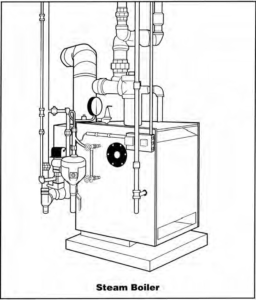
Steam Boilers

They’ve been with us for over two hundred years, and most of
the time they’re so reliable most folks don’t give them much
thought. They sit in buildings all over the world, transferring
heat from fuel to water, allowing us to warm our buildings or
complete our processes.
Steam boilers are simple, efficient and reliable. No machine
does a better job of moving BTUs from one place to another.
We’ve used them for space heating since before the United
States Civil War in 1861.
Even before the Civil War, we used steam boilers for industrial
processes. Today we use them to run factories, press clothes,
wash dishes, pasteurize milk, sterilize medical equipment,
and to heat entire cities! Their capabilities seem endless.
But despite its simplicity, any steam boiler can run into trouble
if its control system doesn’t act properly. If the energy you put
into the boiler exceeds what the boiler can absorb, the boiler
can rupture. So you must always be on guard.
A simple safety relief valve of the right capacity and relief-pressure
setting protects the boiler from over pressure. But over
pressure isn’t the only thing that can threaten a steam boiler.
There are also the dangers of dry firing.
Should the internal water level drop too low, the boiler can
burn out. So here too, you must always be on guard. You
see, a steam boiler needs its water to move the heat away
from its metal surfaces. Without the right internal level of
water, heat quickly accumulates. Too much heat creates a
very dangerous operating condition